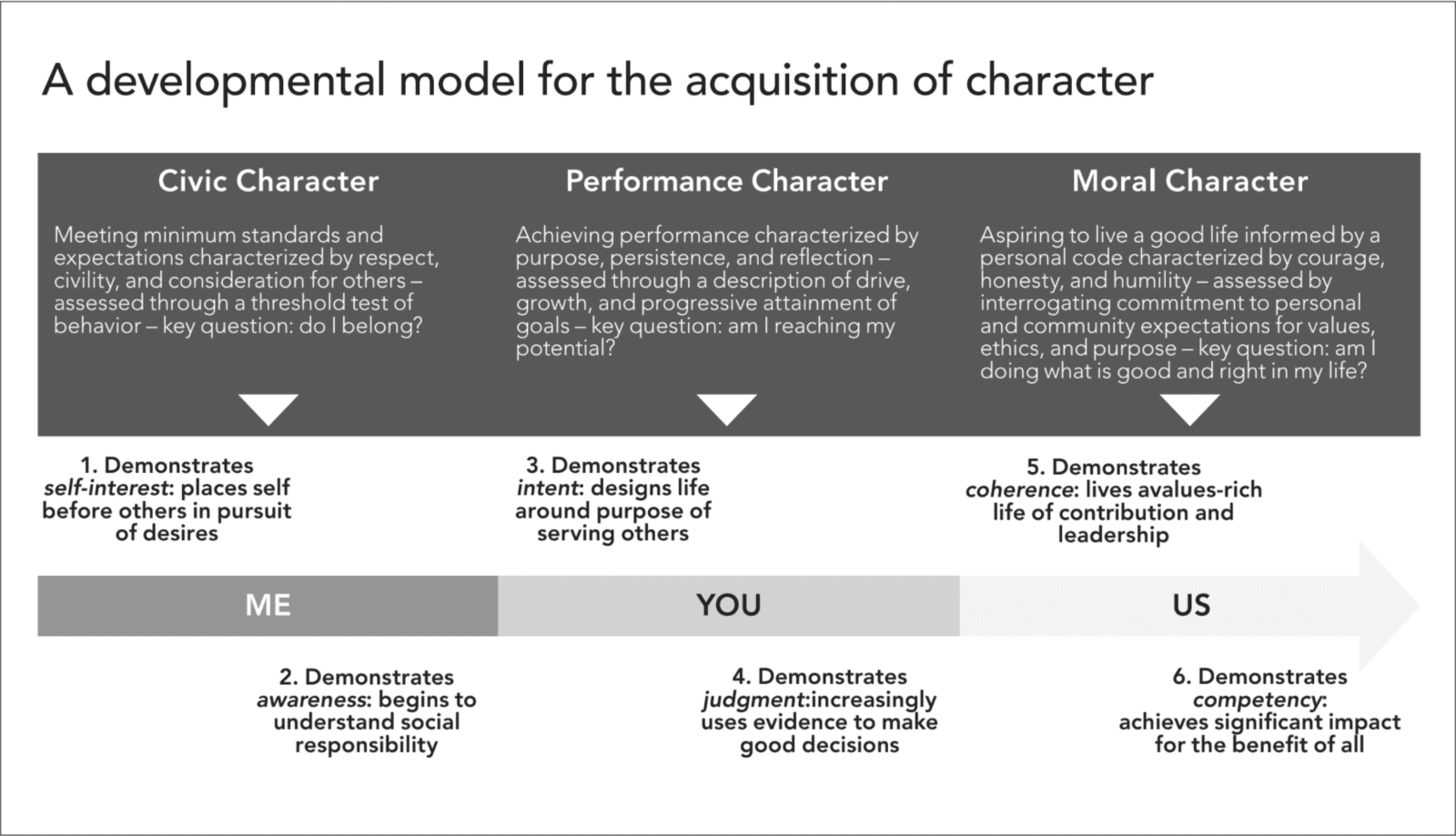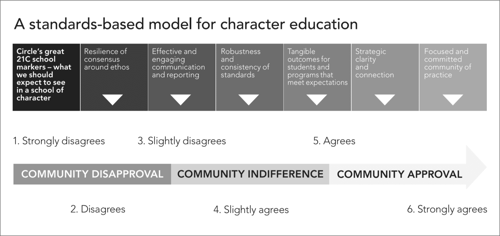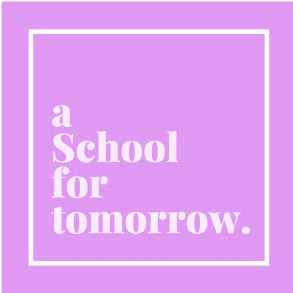The Way | Learn | The Whole Work of a School
Measuring Character Development And Character Education
Measuring character development is about measuring the journey towards servanthood and the acquisition of competence through an education for character. We believe that we can use a model for the acquisition of character competency that traces the journey from ‘me’ to ‘you’ to ‘us’. A competency is the capacity of students to demonstrate how they have grown in an educational process that asks them deliberately and simultaneously to know, to do, to be, and to learn. Character competency is the cultivation and demonstration of those strengths, qualities, and outcomes that are aligned with the values, dispositions, and actions that are associated with civic character, performance character, and moral character – a sense of belonging developed in response to their meeting civic obligations, the fulfilment of potential through the increasing attainment of performance standards, and the capacity to reflect on what is good and right for them to do in their lives, especially in the light of their ongoing moral challenges. This can be measured on a developmental continuum that moves from the expression of self-interest, to awareness, to intent, to judgment, to coherence, and finally, to competence.

We believe that character education is the articulation and application of a school’s whole program of education to build capacity in character competency through the development of rigour in character practice, expertise in character apprenticeship, depth in character leadership, and richness in character capital. We can measure the success of a school’s overall program of character education according to six key markers that show us the critical components for success in character education: resilience of consensus around ethos, effective and engaging communication and reporting, robustness and consistency of standards, tangible outcomes for students and programs that meet expectations, strategic clarity and connection, and a focused and committed community of inquiry and practice. We can measure these markers according to their observable consistency and quality of execution across a school, especially across three dimensions of character learning (contexts, design and experiences).
How might we measure the development of civic, performance, and moral character? We need an approach to measurement that asks us to situate our personal professionalism within a community of inquiry and practice that is focused identifying and analysing evidence about how best to bring out character competencies and assess them.

Measuring Character Development: From Me to You to Us
How might we apply this more specifically to our understanding about the development and assessment of civic, performance, and moral character?
What we have said in terms of 'measurement of civic character’ (or adherence to rules and principles defined for us by the community in which we live) is that we can begin by using a threshold test. If students reach an acceptable standard, then they are deemed to belong. This might suggest that if they do something often enough then they might ‘join the club’, as it were. The challenge with this is that this is what applies easily to the lesser rules – if you wear the right uniform and wear it correctly, then you’re in, so to speak. For these types of rules, we would probably veer towards defining each strength and then using a frequency scale that measures consistency of demonstration of those strengths. What happens, though, when a student breaks a big rule? What happens if, for example, the student visits significant violence on another person? Frequency of occurrence most likely will not govern the judgment of consequence under these circumstances, as if a student breaks a big enough rule then the civic code will clearly have been broken and the privileges or even membership of the group will be withdrawn, either temporarily or permanently. Thus, within civic character, we have a balance to take into account between the prevailing conditions and the measurement of compliance and transgression that apply to high-stakes rules and those rules that are deemed to be of less import. Civic character begins with meeting rules that can be easily measured through a threshold test. As this compliance subsequently becomes practice centred around a deeper and richer agency in, and responsibility for, community life and obligations.
We believe that we can exercise the measurement of performance character against progressive attainment of competency standards and calibrate these against the setting and attaining of goals for performance. We can describe what these strengths of purpose, persistence and reflection look like when they are exercised in both an individual and collaborative sense. In particular, in both the popular and academic literature there is an abundance of reference to concepts such as grit, resilience and drive that can sit easily within the notion of performance character (and elsewhere). We also believe that it is possible to chart a linear progression for a combination of purpose, persistence and reflection through a combination of disposition and the exercise of skill:
Demonstrates Self-Interest
We live with no clear goal or direction and act responsively and in pursuit of attractions that appear in the moment with little regard for the consequences of our actions for a preferred future.
Demonstrates Awareness
We acquire an interest in an area or a cause or a mission and begin to reject those choices available to us which conflict with this sense of mission.
Demonstrates Intent
We begin to define broad goals and strategies to achieve our mission then apply these to our daily lives.
Demonstrates Judgment
We begin to gather evidence to test how successful we are with our goals and make judgments about how well we are working towards our mission and what we might need to do to make the achievement of our mission more likely.
Demonstrates Coherence
We successfully link our goals, activity and achievement back to the cause we established for ourselves and use evidence with confidence to make fundamental decisions about whether we should continue or make changes to our course of action when necessary.
Demonstrates Competence
We consciously and consistently align our lives to our mission and use a deep understanding of the evidence available to us about what we are doing to shape the deployment of our actions, energy and resources to the fulfilment of this mission.
When it comes to the measurement of moral character, many of us are troubled by the idea of grading a person’s morality. Our colleagues, internationally, (and we think we are with them on this) resist strongly, by and large, awarding grades for moral character qualities such as integrity, courage, honesty and so on. Many would argue, for example, that you can’t get a ‘B minus’ for integrity – you either have it or you don’t. Instead, we have said that we want to be able to comment on the quality of students’ interrogation of these concepts in their lives. We want to be able to identify how successfully they are able to align their values, intentions, actions, and impact. In other words, not only are we interested in integrity as a strength of character, we are also interested in the structural integrity of how what they do aligns with what they believe, and the consequences of this for themselves and others. If we pursued this approach, we might be able to assess the following combination of qualities of courage, honesty, and humility accordingly:
Demonstrates Self-Interest
We make choices in our lives that are situated in a sense of right and wrong that is informed by a strong sense of personal ambition and of what we believe is in our own interests.
Demonstrates Awareness
We show an appreciation of the need to forego self- gratification and personal convenience and to build a set of personal moral values that are informed by the courage to do what is right, the honesty to reflect on ourselves with candour, and the humility to understand our true situation in our world.
Demonstrates Intent
We state a commitment to living a life based on a set of principles strengthened by our desire to show courage, honesty and humility and can relate an appropriate narrative of how well and how consistently we do this in the company of others and when no one else is present.
Demonstrates Judgment
We design and implement processes to help us to evaluate how successful we are in creating tangible links between what we say and what we do to ensure that we can make a valid assessment about whether or not we are doing the right thing in our lives.
Demonstrates Coherence
We demonstrate our desire to become better people, to augment our contribution to the wellbeing of others, and to amend some of the choices we have made through brave, honest, and self-effacing self-reflection, by taking on the constructive feedback and advice of others, and by providing such feedback to others when it is our turn to do so.
Demonstrates Competence
We routinely interrogate the alignment of our values, intentions, actions, and impact on ourselves and others, and we challenge ourselves and others to become people whose lives add to the sum of our collective humanity and the good of our world.
If this is how we might measure the development of character on the left-hand side of our model for character education, let us now consider the right-hand side zone and explore the nature and measurement of character education. To do this, we will need to unpack the organisation and alignment of a school according to our six corridors of an excellent 21C education.
Schools should situate the goal of graduating competent local, regional and global citizens within the process of building school strategy. They should be inherently dissatisfied with the status quo, and redesigning the vision, direction, structures and processes required to create a great school that graduates fit for purpose citizens.
Building school culture is the strategic lever that most influences an education for character competency that produces good people. They are focused on the fundamental purpose of a school of character – an education for 21C character and competencies. They earn a strong and credible reputation as a great 21C school of character. They focus on their organisational integrity by ensuring consistency in the application of their ethos, engagement with their community, thoroughness in their planning, the quality of their outcomes, the execution of their strategy, and the efficiency and efficacy of their processes across the domains of reputation, communication, evaluation, achievement, initiatives, and relationships. The key marker of success in such a school in this corridor can be found in the resilience of consensus about ethos. They are true to the stated values and purpose of our school. They are strengthened by the robustness and resilience of their ethos, particularly through the alignment of their stated and unstated culture as demonstrated in the connections between their community’s words and its deeds, particularly the daily activity of students, staff and leaders.
They agree on what matters to them. They promote and reinforce the resilience of consensus around ethos by promoting shared intentional, aspirational, and practical values, intentions, and principles that enable the community to withstand the challenges of conflicting goals and hidden assumptions about educational design and delivery.
To graduate future builders who are adept in the competency of communication, schools need to build leadership that is similarly focused significantly on the future of their community. They apply models and frameworks of positive leadership that balance the need to honour the past and address the demands of the present while prioritising looking forward to a preferred future. In the domain of communication, they share a narrative of our growth and development as a future-focused school. They manage the complexity of their leadership by listening to the school community carefully, connecting and communicating with it, and creating a credible story of the progress of the school that honours the legacy of its past, frames the requirements of its present, and projects a compelling rationale for a preferred future that is best served by authentic learning experiences based on 21C character and competencies. They help our community to come along with us on their journey through their community engagement. They are energised by deliberate, targeted and intentional approaches to community engagement that are informed by both an understanding of the relationships between what stakeholders want and need, and what the school promises and delivers on an ongoing basis in building a school for the future. They talk about and report on their work consistently and with quality. They engage with their community and engage the progress of their work towards their preferred future through effective and engaging communication and reporting.
Schools of character who exercise the strategic lever of building learning are likely to have more graduates who can learn and unlearn continuously as a consequence of their competency in change readiness. They have an agreed approach to learning in their community. They are consistently institutionalising the desire to learn from all of their experiences to improve outcomes for more learners. In the domain of evaluation, they measure what they do. They routinely gather and evaluate data- based evidence of agreed school growth and transformation that relate to the core learning, leadership, character, service, sport, co-curricular and developmental activity of the school in particular, as well as the financial, governance and business stewardship of those resources needed to attain the educational mission of the school. In their planning, they are deliberate, targeted and intentional in our approach. They are driven by a relentless passion for and shared practice in setting, planning for, attaining, and (where possible) improving the school’s capacity to deliver outcomes for its learners by building cultures of excellence in leadership and learning, and cumulative internal data-gathering, regular programs of review, and external research of other available options.
They define and improve their standards. They encourage the ongoing growth transformation of the school by setting robust and consistent standards, providing support, monitoring progress, recognising success, and encouraging accountability.
Schools of character use the strategic lever of building performance to encourage graduates to become solution architects who display the competency of creative and critical thinking. They recognise and work towards high performance. They appreciate the importance of evidence-based high performance as a point of focus developing solutions for building cultures of excellence in leadership and learning in the school. They believe in their capacity to solve problems and meet the expectations of their community in a structured fashion. They assert confidence in the capability of all to be successful and privilege the disciplined pursuit of achievement by encouraging the attainment of individual and collective goals that challenge them to move beyond where they are now towards what they might become in the future. They achieve their goals and meet their community’s expectations. They are committed to the identification of the broad and deep nature of community satisfaction with the school by testing the validity of assumptions and anecdote against key data about performance in the key academic, pastoral, and business outcomes of the school.
They achieve tangible outcomes for students and programs that meet expectations. They establish and achieve both process and product goals for students and programs that are appropriate to both the context of the learning environment and the deliberate and targeted focus of learning, particularly in the areas of student care and character, learning culture across the curriculum and co-curriculum, design and delivery of student programs and pathways, the promotion of student voice and leadership, diversity, innovation, and future readiness.
Schools should situate the goal of graduating competent local, regional and global citizens within the process of building school strategy. In this respect, they should aspire to be a strategically envisioned and operationally aligned community. They should be inherently dissatisfied with the status quo, and redesigning the vision, direction, structures and processes required to create a great school that graduates fit for purpose citizens. They should use projects and initiatives to help them realise their intent. They should use a balanced perspective to invest significant hope, resources and commitment into research and development by planning, conducting, and evaluating intentional projects and initiatives that are aligned to the school’s mission to educate 21C citizens. They do what they say they will do.
They are guided by a common understanding of and judgment about a strategic intent that is most visible in the close and mutually supportive relationship between their strategic vision, leadership, operations, governance, and culture. They are clear about their intent and what they do is aligned with this intent. They reinforce strategic clarity and connection school activity by aligning school culture with strategy and translating this into daily operations.
Finally, the strategic lever that is most pertinent to graduating team creators who are fluent in the competency of collaboration is building systems and operations. Such schools use systems and operations to bring people together. They nurture effective learning relationships and support an appropriately resourced community of inquiry and practice. They build robust and resilient learning relationships within this community of inquiry and practice. They work to build relational systems and operations, inspired by a desire to improve the outcomes of their learners, especially in 21C character and competencies so that they are equipped, empowered, and enabled to assume responsibility for making a positive contribution to the world. They use the best possible processes. They are enhanced by routine habits of researching, identifying and implementing the best possible relational systems and operations approach for teaching and learning, research and that unlocks defensive default development, information recording and positions, while supporting individual and tracking, evaluation and decision-making, and collective improvement in formal and informal resourcing, and other business functions.
They work together to improve what they do as a focused and committed community of inquiry and practice, especially for their students. They prioritise the establishment and continuous refinement of process, systems and operations that nurture a school-wide, future-focused, and evidence based approach that unlocks defensive default positions, while supporting individual and collective improvement in formal and informal learning culture and practice. From these learnings about the operation of schools of character, we can distil a model that can help with measuring organisation of a school for an excellent 21C education within our six corridors is as follows:

Measuring Character Education: From Disapproval to Indifference to Approval
We believe that if educators want to go looking for quality and consistency of an education for 21C character and competency, then they should look to these six markers and the extent to which their community truly believes in how well they are in place. If we can now recognise the journey towards servanthood and the six markers by which we might measure the success of the whole work of a school according to the community’s acceptance of the quality and consistency of character education, then how and where might we apply this in more granular fashion to the core learning activity of the school?






